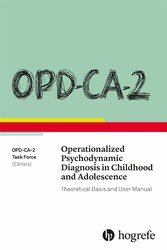Search and Find
Service
More of the content

OPD-CA-2 Operationalized Psychodynamic Diagnosis in Childhood and Adolescence - Theoretical Basis and User Manual
1. Introduction
Beginning in 1992, the Operationalisierte Psychodynamische Diagnostik (in English Operationalized Psychodynamic Diagnostics, OPD) for adults was developed for German-speaking countries (Arbeitskreis OPD, 1996) and then later revised (Arbeitskreis OPD, 2006). The English versions of the Manual were published a bit later (OPD Task Force, 2001, 2008). The OPD is a system with psychodynamically based diagnostic axes for supplementing and expanding nosological classification schemes (such as DSM-5 in the USA, American Psychiatric Association, 2015; ICD-10 in Europe, World Health Organisation, 1992).
The result is an instrument that both takes into account psychodynamic theory and attempts to improve interrater reliability in the psychodynamic assessment of mental states. This instrument is intended to remedy the fuzziness of psychoanalytic concepts – often criticised by other therapy approaches – through definitional principles. Of course, the reduction of fuzziness and ambiguity necessarily entails a curtailment of some theoretical models, which is appropriate given the practical diagnostic and therapeutic considerations.
From the outset, the OPD and the Operationalized Psychodynamic Diagnosis in Childhood and Adolescence (OPD-CA; in German Operationalisierte Psychodynamische Diagnostik im Kindes- und Jugendalter [OPD-KJ]; Arbeitskreis OPD-KJ, 2007) aimed at complementing the categorical approach (in terms of diagnoses) with a dimensional view of mental disorders in terms of ratings of severity along different axes (or dimensions). This approach to the classification of mental disorders has proven to be forward-thinking and ground-breaking, as the current developments in the new DSM-5 show, in which dimensional perspectives and assessments of severity have now been integrated into the categorical system of psychiatric diagnoses (APA, 2015).
In the case of children and adolescents, the continued development of the ICD-8 and ICD-9 very early on led to a multiaxial nosological framework (Remschmidt & Mattejat, 1994; Remschmidt, Schmidt & Poustka, 2008; Rutter, Shaffer, & Sturge, 1975). This allowed diagnostics on several levels: Along the first axis the clinical-psychiatric syndrome is described, while the second axis allows coding of developmental disorders, the third records intelligence, and the fourth diagnostically classifies physical illnesses as well as disabilities. The fifth axis captures associated abnormal psychosocial circumstances, and a sixth axis ascertains the level of psychosocial functioning. A task force was established in 1996 with the aim of developing a German instrument for the Operationalisierte Psychodynamische Diagnostik im Kindes- und Jugendalter (OPD-KJ; Arbeitskreis OPD-KJ, 2003, 2007; Operationalized Psychodynamic Diagnostics in Childhood and Adolescence [OPD-CA] in English). The aim was to capture, similar to the adult version, psychodynamic aspects of childhood and adolescence, extending beyond the multiaxial classification system, as an aid to appropriate treatment planning.
Based on the OPD instrument for adults, profound modifications were necessary for childhood and adolescence. The central issue was the influence of developmental processes on the psychodynamics. The second edition of the German classification system OPD-KJ-2 combines psychodynamic, developmental, and clinical psychiatric perspectives (Resch & Koch, 2012; Resch, Schulte-Markwort, & Bürgin, 1998; Windaus, 2012). Multidimensional models of the origins of mental disorders are included (Herpertz-Dahlmann, Resch, Schulte-Markwort, & Warnke, 2008) and integrated in an overall biopsychosocial model open to dynamic perspectives (see Chapter 2 Developmental Concepts and Ages). The OPD-CA-2 should accordingly take into account the following special therapeutic considerations: It should allow a good differential indication for therapy and treatment planning given psychodynamic considerations, as well as provide information for a relationship- based foundation for parental work, and, for practical purposes, maintain a sufficiently high level of differentiation and comprehensibility despite the high level of complexity. The psychodynamic approach to the child indeed requires correspondingly complex, multidimensional, and development-oriented diagnostics, and may not remain at the level of nosological assessment.
All prices incl. VAT










